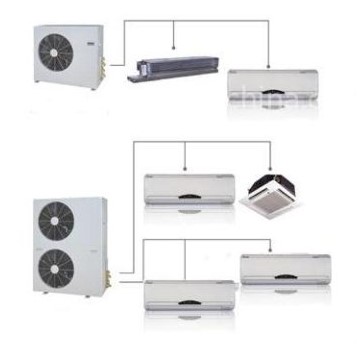Multi-Split System Air Conditioner Size Chart
Choosing the right size multi-split system air conditioner for a home on the Northern Beaches in Sydney, NSW, involves calculating the cooling and heating needs for multiple rooms while considering the local coastal climate, room sizes, insulation, and system efficiency. A multi-split system connects one outdoor unit to multiple indoor units, ideal for cooling/heating several rooms with individual temperature control. Below is a guide to determine the appropriate size, measured in kilowatts (kW) of cooling/heating capacity.
| Home Type | Number of Rooms | Total Area (m²) | Outdoor Unit Capacity (kW) | Sample Indoor Unit Configuration (kW) |
|---|---|---|---|---|
| Small Home | 2–3 | 40–60 | 5.0–8.0 | 2.5 + 2.5 + 3.5 |
| Medium Home | 3–4 | 60–100 | 8.0–12.0 | 2.5 + 3.5 + 5.0 + 2.5 |
| Large Home | 4–6 | 100–150 | 12.0–16.0 | 2.5 + 3.5 + 5.0 + 6.0 + 2.5 |

Key Factors for Sizing a Multi-Split System
- Room Sizes and Total Area
- Measure the area of each room to be cooled/heated (Length x Width in square meters).
- Note ceiling height (standard ~2.4m; higher ceilings increase capacity needs).
- Sum the areas for an overall estimate, but prioritise individual room requirements.
- Cooling Capacity Rule of Thumb
- In Sydney’s temperate coastal climate, use 0.125–0.15 kW per square meter for well-insulated rooms with moderate sun exposure. Adjust for:
- Sun exposure: Add 10–20% for rooms with large north- or west-facing windows.
- Insulation: Poor insulation may require 20% more capacity.
- Ceiling height: Add ~10% per 0.5m above 2.4m.
- Occupancy: Add ~0.5 kW per extra person (beyond 2 per room).
- In Sydney’s temperate coastal climate, use 0.125–0.15 kW per square meter for well-insulated rooms with moderate sun exposure. Adjust for:
- Heating Capacity (Reverse-Cycle)
- Most multi-split systems are reverse-cycle, providing heating for mild Northern Beaches winters (8–18°C).
- Heating capacity should match or slightly exceed cooling needs for year-round comfort.
- Multi-Split System Considerations
- Outdoor unit capacity: The outdoor unit’s total capacity must support the combined demand of all indoor units, but indoor units typically don’t run at full capacity simultaneously (diversity factor).
- Indoor unit sizing: Each indoor unit should match the specific room’s needs (e.g., 2.5 kW for a small bedroom, 5.0 kW for a living room).
- Piping and efficiency: Longer piping runs (indoor to outdoor unit) may slightly reduce efficiency, so professional design is key.
- Northern Beaches Climate
- Coastal humidity increases perceived warmth, so prioritise units with dehumidification.
- Inverter technology ensures energy efficiency and stable temperatures.
General Sizing Guide for Individual Rooms
Based on industry standards and web sources:
- 10–20 m² (small bedroom): 2.0–2.5 kW
- 20–30 m² (medium bedroom or small living area): 2.5–3.5 kW
- 30–45 m² (large living room): 4.5–6.0 kW
- 45–60 m² (open-plan area): 6.0–8.0 kW
Sizing the Outdoor Unit
- Total capacity: Sum the kW requirements of all rooms, then apply a diversity factor (typically 70–80% of total capacity, as not all units run at max simultaneously).
- Example: For three rooms needing 2.5 kW, 3.5 kW, and 5.0 kW (total 11 kW), an outdoor unit of ~8–9 kW may suffice, depending on the brand and model.
- Common outdoor unit sizes range from 5.0 kW (for 2–3 small rooms) to 12–16 kW (for 4–6 larger rooms).
Example Scenario
For a Northern Beaches home with:
- Bedroom 1: 15 m² (2.5 kW needed: 15 x 0.15 kW/m²).
- Bedroom 2: 20 m² (3.0 kW: 20 x 0.15 kW/m²).
- Living Room: 40 m² (6.0 kW: 40 x 0.15 kW/m², adjusted for large windows).
- Total: 2.5 + 3.0 + 6.0 = 11.5 kW.
- Outdoor unit: A 9–10 kW outdoor unit (e.g., Daikin Super Multi NX or Mitsubishi MXZ series) could handle this, assuming a diversity factor of ~80%.
Recommendations for Northern Beaches
- Small home (2–3 rooms, 40–60 m² total): Outdoor unit of 5.0–8.0 kW with 2–3 indoor units (e.g., 2.5 kW + 2.5 kW + 3.5 kW).
- Medium home (3–4 rooms, 60–100 m² total): Outdoor unit of 8.0–12.0 kW with 3–4 indoor units (e.g., 2.5 kW + 3.5 kW + 5.0 kW + 2.5 kW).
- Large home (4–6 rooms, 100–150 m² total): Outdoor unit of 12.0–16.0 kW with 4–6 indoor units.
- Brands: Daikin, Mitsubishi Electric, Fujitsu, and Panasonic offer reliable multi-split systems with inverter technology and high energy ratings.
Additional Tips
- Professional Assessment: Engage a local expert like Platinum AC for a heat load calculation and system design. They’ll assess insulation, window orientation, and piping layout.
- Energy Efficiency: Choose high star-rated inverter systems to minimise running costs, especially with coastal humidity and frequent use.
- Installation: Multi-split systems are complex due to piping and electrical requirements. Ensure licensed installers handle the job. Costs are higher than single splits (starting ~$3,000–$5,000 for 2–3 rooms).
- Regulations: Outdoor units must comply with NSW noise and placement rules (e.g., not on walls facing primary roads). Most are exempt from development, but check with your local council.
Next Steps
- Provide specific room sizes, ceiling heights, and conditions (e.g., window exposure, insulation) for a tailored recommendation.
- Contact Platinum AC multi split air conditioner installers for on-site quotes to confirm outdoor unit capacity and indoor unit placement.
If you share details about your home (e.g., number of rooms, sizes, or layout), we can refine the sizing estimate further!



